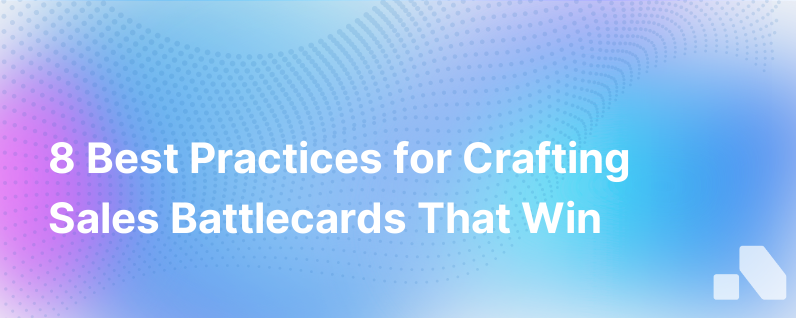
Imagine going to battle without a strategic plan or a map that outlines your exact steps towards victory. Your chances of success would be significantly diminished. Similarly, sales reps going into the competitive landscape without sales battlecards stand the chance of failing to articulate their value proposition effectively or answer a prospect's questions convincively.
Sales battlecards are powerful tools that direct sales conversations and handle objections successfully. These are concise collections of targeted information about your product, competition, and market that give your sales team the necessary ammunition to win conversations.
However, not all battlecards are created equal, and the effectiveness of your battlecards hinges on some key best practices.
1. Make it Actionable
One of the key objectives of a battlecard should be to direct an action. It should guide your sales reps on the appropriate steps to ensure a successful deal. Each card should contain a clear call-to-action that aligns with your overall sales strategy. The action could be a talking point, a counter-argument, or a unique insight about your product that differentiates your business.
2. No Information Overload
Less is more when it comes to battlecards. Overloading your battlecard with too much information makes it difficult for salespeople to find the specific information they need during a sales call. The goal is to provide the most important and necessary information in the clearest and most concise manner possible.
3. Regularly Update
The market, competitors, and your own product or services keep evolving. Therefore, it’s essential to update your battlecards regularly, ensuring that the information stays relevant. Implement a system or use platforms like Aomni to automatically update your battlecards based on real-time data.
4. Make it Easy to Digest
Nothing kills a sales pitch faster than complexity. The same goes for battlecards. Ensure they are simple, easy-to-understand, and visually appealing. Think of it in terms of design, use of color, and topic segmentation for easy navigation.
5. Tailor it to the Prospective Customer
Understanding your target audience is crucial to build efficient battlecards. When developing a battlecard, consider the needs, wants, preferences, and pain points of your potential customers, only then can you focus your efforts on developing action points that resonate with them.
6. Don't Neglect the Competition
Remember, your sales reps aren't just selling your product or service — they're also selling against your competitors. Highlight the key differences between your offerings and competitors' products or services. Include information about their pricing, features, and benefits, then compare them against your own.
7. Involve Your Team in Creation
The best battlecards are those created with the input of those who will use them. Fresh insights, experiences, and ideas from your sales team can make the battlecards more relevant and effective.
8. Test and Iterate
Battlecards are not a ‘set and forget’ type of project. Their effectiveness should be measured and optimized. Use their performance data to enhance their relevance and efficiency.
Conclusion
Sales battlecards are indispensable tools that help sales reps communicate confidently, handle objections professionally, and close deals successfully. A properly designed and managed battlecard gives your team an edge over the competition, equipping your reps with the right information at the right time.
However, maintaining up-to-date, easy-to-understand battlecards is quite the task. It is an ongoing process that requires constant review and revision, which can be overwhelming. To alleviate this, predictive sales platforms like Aomni can provide continual updates to your battlecards, ensuring that your sales reps have the latest and most relevant information to win deals. By implementing these best practices and leveraging AI, you ensure your sales reps can successfully navigate the competitive sales landscape.